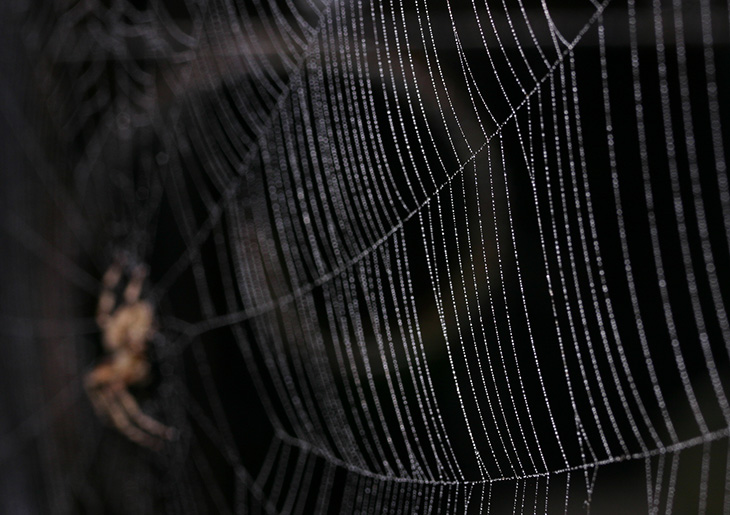A few years ago, I would have skipped doing any reviews of this nature, because the books I refer to had a limited run from American publishers and are nearly all out of print now; some of them never actually had a US publication, since the author is British and they were primarily published in England. With the internet, however, it is now possible to find just about any book, given a little patience and search skills, and have it shipped to you from nearly any continent. So I can’t feel bad about making any such recommendations now.
I’ll also note that I don’t like over-generalizations; I think as a species we seek patterns and simple answers, and thus often force things to fit some overall category in which they do not reasonably belong. Much as I like many authors, there are also bad examples of their work, and much the same can be said of musicians, so I usually aim for specific works to review instead.
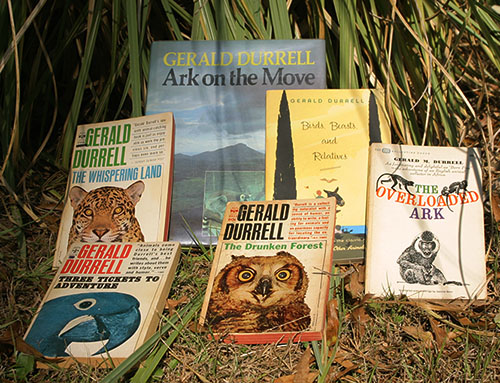 Gerald Durrell is an exception, primarily because he’s produced far more great works than dismal ones, but also because I cannot bring myself to choose just one book to review. There are too many gems to think selecting one is doing justice (and one should not take the image at right to be a guide – it was dictated by aesthetics, not favoritism.)
Gerald Durrell is an exception, primarily because he’s produced far more great works than dismal ones, but also because I cannot bring myself to choose just one book to review. There are too many gems to think selecting one is doing justice (and one should not take the image at right to be a guide – it was dictated by aesthetics, not favoritism.)
Nearly all of Durrell’s works are semi-autobiographical, in that they chronicle his experiences in naturalism and conservation, from a boy growing up on the Greek island of Corfu to establishing his own zoo and endangered wildlife trust in Great Britain. And I admit to some suspicion about embellishment (stung by much of James Herriot’s work,) since he relates a large number of peculiar characters and unique situations, which brings up a curious aspect within the genre. Authors working on pure fiction can freely use such things, since there is a suspension of disbelief when one reads those works. But non-fiction is expected to maintain accuracy, and the tales of peculiar individuals or situations within capture our attention because of their outrageousness. Few authors can resist adorning their work with not-strictly-accurate representations of encounters, conversations, and personalities, but how much is allowable?
In most of the stories within Durrell’s books, it probably doesn’t matter. Because the charm of the books isn’t solely the appeal to the animal lover, or conservationist, or naturalist, but also the distinctive way he relates his subject matter. Durrell is one of the very few writers I’ve ever come across who can describe a species not just succinctly, but accurately enough that years later, I could see a photo of an animal for the first time and confidently say, “That’s an agouti.” Nor does he limit his descriptive powers to animal identification, as he paints the landscapes and expressions of his experiences in a manner that straddles the line between illustration and poetry. From The Whispering Land, on his chance encounter with a guanaco while sleeping under their Land Rover in Argentina:
He turned his head, sniffing the breeze, and I could see his profile against the sky. He wore the supercilious expression of his race, a faint aristocratic sneer, as if he knew I had slept in my clothes for the past three nights. He lifted one forefoot daintily, and peered down at me closely. Whether, at that moment, the breeze carried my scent to him I don’t know, but he suddenly stiffened and, after a pause for meditation, he belched.
It was not an accidental gurk, the minute breach of good manners that we are all liable to at times. This was a premeditated, rich and prolonged belch, with all the fervour of the Orient in it. He paused for a moment, glaring at me, to make sure this comment on my worth had made me feel properly humble, and then he turned and disappeared as suddenly as he had come, and I could hear the faint whisper of his legs brushing through the little bushes.
That passage also illustrates his sardonic humor, as much a part of his writing (and, one would guess, his life) as naturalism. On reading the books about his youth in Corfu, it’s easy to see that he was raised in this environment, most especially courtesy of his older brother Larry, better known as the author Lawrence Durrell. It is entirely possible that his brother’s interest in literature fostered his own writing skills, though his accounts of profound resistance to any education that did not include animals seems to belie that notion. But since biting commentary is the trait of his brother’s most emphasized in those stories, one can be excused for believing this was the prime influence.
Most of Durrell’s books chronicle his efforts to collect animals for zoos in the 1950s through 1970s – after that time, obtaining animals from the wild was on the wane and endangered species programs were coming into their prime, largely due to Durrell’s own influence, and he also had a zoo of his own that he had established. But those earlier collecting trips reflect a fascinating period in many of these areas, touched only lightly by industry and technology, not yet affected by the globalization that was to come. Entire camps were transported to their destinations by ancient trains, Land Rovers, horses, and native porters, many of whom accepted cigarettes or shots of whiskey as tips. Durrell’s observations of not just the local wildlife and scenery, but the native customs (including, too often, the Customs procedures themselves,) paint exotic cultures that are next to impossible to find anymore.
Some of these portions may strike the reader as somewhat racist, especially Durrell’s renditions of local languages or his casual callousness at times – we have now grown hypersensitive to such issues. Yet his sarcasm is not restricted to natives, imparted equally to even his wife, and these aspects should be viewed through the perspectives of the time. Some of his destinations in Africa, for example, were in the last vestiges of British colonialism, and the natives really did speak pidgin English and refer to all whites as “massa.” Contrasted against Durrell’s distaste of arrogant classism, and his delight in native dances and songs, any discomfort over such passages is likely more a product of our current attitudes rather than an indication of Durrell’s.
It must be said, these are all animal books, first and foremost, and the accounts split their time equally with the rigors of caring for so many different species, and Durrell’s observations of their traits and personalities. Moreover, I need to emphasize his approach from a practical, objective standpoint – these are not books of spirituality, ‘communication,’ or seeking some connection with any particular species; those are all human traits, and nonsense ones at that. Durrell may describe animals, as above, in terms we relate to, but does not even faintly ascribe our traits to any other species, offering keen observations in place of imagined qualities – the books, even of his childhood, are from the perspective of a scientist, not a spirit guide, and he takes pains at times to correct the impressions of those who fail to understand what animal work is truly about. I was about to remark, as a wildlife rehabilitator, how appropriate I find this approach, before realizing that these books are a large part of why I become involved in rehab. And thus, for anyone interested in pursing that, or any other animal-related field, I can say that the perspective given in the books, especially those of his collecting trips and establishing his own zoo, provides an accurate expectation of the tasks and effort involved.
(As a brief aside, reminded by the ‘spirit guide’ comment, his chapter in Birds, Beast, and Relatives on attending a séance in London is one of the funniest things I’ve ever read, and even delightful from a skeptic’s standpoint.)
Durrell also penned several tomes on his youth, a few collections of short stories from various points in his life, and even some works of fiction aimed at both adults and kids. Only sporadic chapters have little to do with animals, but more than a few concentrate on his interactions with family, friends, and random characters, often giving the impression that he wades through an ocean of eccentricity as the only one who can see the absurdity of it all (and relate it hilariously as well.) However, it is also not hard to find the tongue-in-cheek references to his own view on things, knowing full well that his overriding interests in animals is hardly considered normal. Yet this never takes on the appearance of obsession; Durrell is accomplished at highlighting what’s interesting about other species, and why, and it’s easy to identify with his attitudes, even when we recognize that dissecting a decaying sea turtle on the porch as a child was probably not his brightest idea.
There is no particular order one should read his books within – the progression of events is minimal – but just to see the development of his writing skills, I might suggest starting with The Bafut Beagles or Three Tickets to Adventure (named in Britain as Three Singles to Adventure,) then through either The Whispering Land or The Drunken Forest, tackling the books of his childhood – My Family and Other Animals and Birds, Beasts, and Relatives (in that order) – in there somewhere. In A Zoo in My Luggage, he begins the saga of his own zoo, which leads to Menagerie Manor and Beasts in My Belfry. However, starting with any book that you lay your hands on is fine.
Durrell also started the Durrell Wildlife Conservation Trust, one of the leading organizations devoted to endangered species, and the zoo he created in A Zoo in My Luggage lives on as the Durrell Wildlife Park – there are, certainly, worse organizations to make donations to. Part of his legacy is also expressed by the existence of eight separate species named in his honor. Despite the predictions of his brothers, Durrell’s interest in animals was not something that he grew out of, thankfully, because it produced a remarkable amount of lasting impact.





















































 I also did lots of other night experiments, but none of them turned out quite the way I wanted; getting the light balanced for night exposures can be tricky, and the LCD on the camera is only partially useful in that regard – it doesn’t give a very good idea of exposure levels, especially not subtleties. During this I was trying to figure out why some of the images seemed to be coming up blurred, almost in a fog, while others were sharp without changing focus at all, until I realized my breath was sometimes fogging up the LCD ;-)
I also did lots of other night experiments, but none of them turned out quite the way I wanted; getting the light balanced for night exposures can be tricky, and the LCD on the camera is only partially useful in that regard – it doesn’t give a very good idea of exposure levels, especially not subtleties. During this I was trying to figure out why some of the images seemed to be coming up blurred, almost in a fog, while others were sharp without changing focus at all, until I realized my breath was sometimes fogging up the LCD ;-) A tripod would have been no real help with this one – it wasn’t the movement of the camera that was the biggest problem, but the gentle bobbing of the saturated plants in the breeze, so the “take lots of frames” technique was the only thing I could count on. In the foreground are the remains of the
A tripod would have been no real help with this one – it wasn’t the movement of the camera that was the biggest problem, but the gentle bobbing of the saturated plants in the breeze, so the “take lots of frames” technique was the only thing I could count on. In the foreground are the remains of the 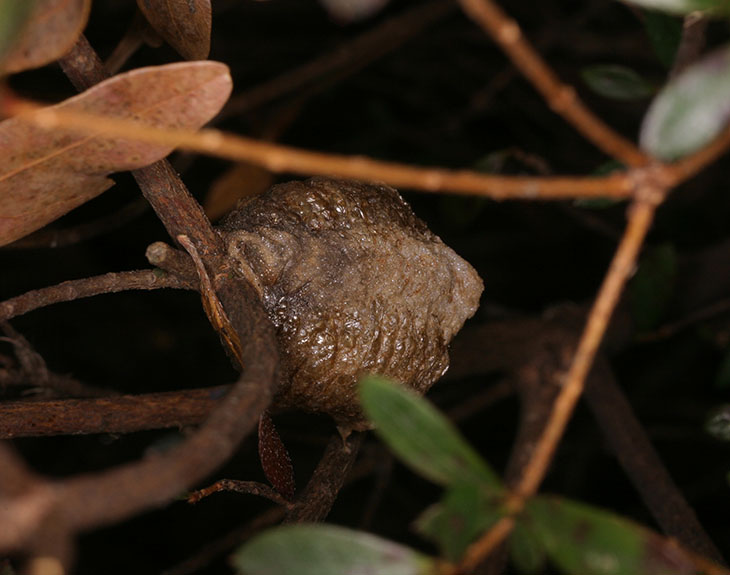
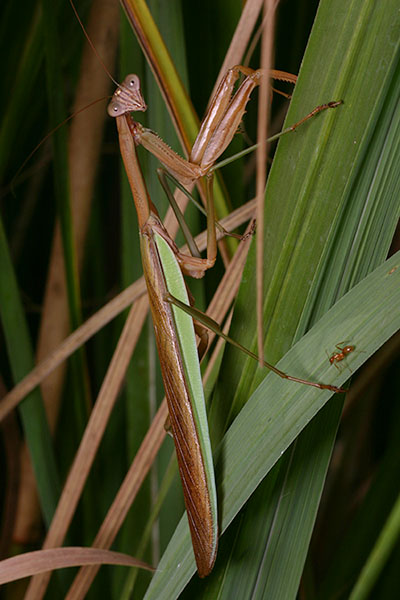 Then she reappeared with a much more trim figure, and I knew I had missed it. In the days leading up to this, she had been found newly molted on one of the front patches of pampas grass (there are three, of two different species,) then spotted on the butterfly bush, a tomato plant, the rosemary bush (where she likely ate one of the
Then she reappeared with a much more trim figure, and I knew I had missed it. In the days leading up to this, she had been found newly molted on one of the front patches of pampas grass (there are three, of two different species,) then spotted on the butterfly bush, a tomato plant, the rosemary bush (where she likely ate one of the 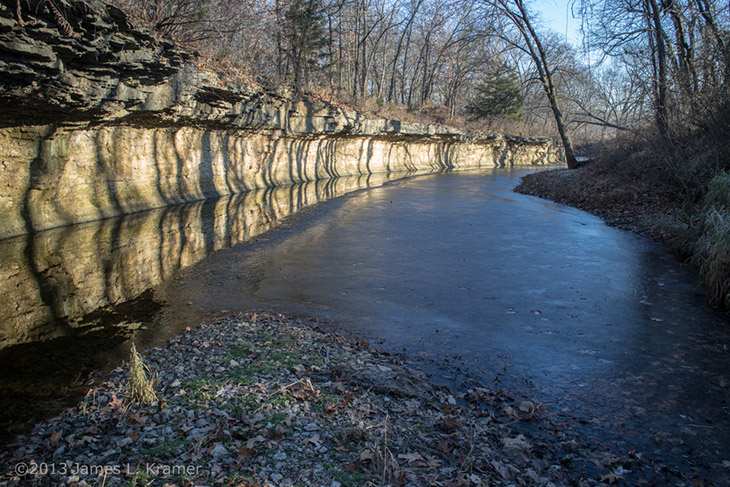

 Sometimes, the surface is as fine as a spider web, which are the best conditions to watch for because a frost-covered orb web is a great photo subject, as you might imagine. I have yet to find all those conditions in place myself – orb webs are often long gone by the time the frost conditions roll in – and to the best of my knowledge Jim hasn’t found them either.
Sometimes, the surface is as fine as a spider web, which are the best conditions to watch for because a frost-covered orb web is a great photo subject, as you might imagine. I have yet to find all those conditions in place myself – orb webs are often long gone by the time the frost conditions roll in – and to the best of my knowledge Jim hasn’t found them either. Which should make the conditions of this next image very obvious – I’m guessing that Jim was working just as the sun broke through, because there’s still frost visible and I imagine it didn’t last long. Either that or it was freakin’ cold. As indicated in the previous post, these are higher contrast conditions – note the bright highlights and distinctive shadows, giving some enhancement to the shape of this seed pod. It also made the bare branches in the background stand out a bit sharper, slightly distracting – much more and it would be working against the image too strongly. Ideally, this is where you try to find a dark background, like a patch of shade, to position behind the seed pod, using that contrast to really make it stand out, but such things can be hard to accomplish. Here’s a sneaky little trick, if you’re prepared: put the camera on a tripod, using a remote shutter release if necessary, and use your own shadow to provide the darker background.
Which should make the conditions of this next image very obvious – I’m guessing that Jim was working just as the sun broke through, because there’s still frost visible and I imagine it didn’t last long. Either that or it was freakin’ cold. As indicated in the previous post, these are higher contrast conditions – note the bright highlights and distinctive shadows, giving some enhancement to the shape of this seed pod. It also made the bare branches in the background stand out a bit sharper, slightly distracting – much more and it would be working against the image too strongly. Ideally, this is where you try to find a dark background, like a patch of shade, to position behind the seed pod, using that contrast to really make it stand out, but such things can be hard to accomplish. Here’s a sneaky little trick, if you’re prepared: put the camera on a tripod, using a remote shutter release if necessary, and use your own shadow to provide the darker background.

 First and foremost, and something I teach my students right off the bat, is that photographs by nature have increased contrast over what we see through our eyes. They have a narrow dynamic range, a term that straddles the border between explanatory and pompous. We all know, for instance, that dogs can hear higher pitches than we can, and perhaps you know that we only see a narrow spectrum of light, unable to discern infra-red and ultra-violet ourselves, much less gamma rays or microwaves. Well, the camera’s much worse than we are, partially because of sensitivity, but mostly because of the limitations of the medium. You can aim right at the sun and get a shot (not recommended actually,) but printed on paper or glowing from a monitor, it will never make anyone look away in tears – it will simply be white. The image has to dump a lot of brightness levels just to work.
First and foremost, and something I teach my students right off the bat, is that photographs by nature have increased contrast over what we see through our eyes. They have a narrow dynamic range, a term that straddles the border between explanatory and pompous. We all know, for instance, that dogs can hear higher pitches than we can, and perhaps you know that we only see a narrow spectrum of light, unable to discern infra-red and ultra-violet ourselves, much less gamma rays or microwaves. Well, the camera’s much worse than we are, partially because of sensitivity, but mostly because of the limitations of the medium. You can aim right at the sun and get a shot (not recommended actually,) but printed on paper or glowing from a monitor, it will never make anyone look away in tears – it will simply be white. The image has to dump a lot of brightness levels just to work.



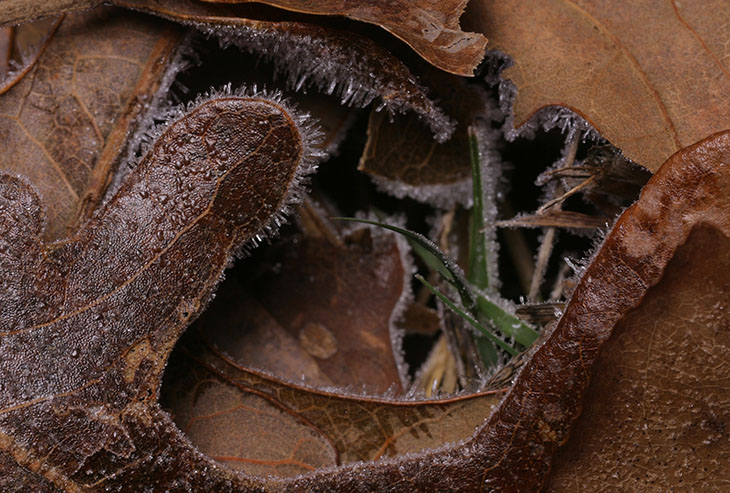
 I thought to check on my green lynx spiders, who had weathered the chill with aplomb (go ahead, picture a spider with aplomb.) This is the first time I never saw mama – she had been looking so decrepit that I was always surprised to find her still around, up until now – but the younguns ventured out as soon as the sun warmed their little chitins. Leaves blown by the wind into the protective cluster of weblines around the former egg sac get incorporated into the shelter, tacked down (I think entirely by accident) with the draglines left by the spiderlings swarming all over them. Still, it’s not much of a shelter when the temperatures drop this far, and I’m impressed with the spiders’ ability to endure the sub-freezing conditions and bounce right back with a little sunlight. There’s fewer of them now, at least some having dispersed by ballooning, but the other two hatchings that I’d observed have vanished almost entirely, so this one has been curiously stable. I plan to keep an eye on it and see what happens – I’m pretty sure these are the offspring of the hatching I observed last year, so they have to do something for the winter.
I thought to check on my green lynx spiders, who had weathered the chill with aplomb (go ahead, picture a spider with aplomb.) This is the first time I never saw mama – she had been looking so decrepit that I was always surprised to find her still around, up until now – but the younguns ventured out as soon as the sun warmed their little chitins. Leaves blown by the wind into the protective cluster of weblines around the former egg sac get incorporated into the shelter, tacked down (I think entirely by accident) with the draglines left by the spiderlings swarming all over them. Still, it’s not much of a shelter when the temperatures drop this far, and I’m impressed with the spiders’ ability to endure the sub-freezing conditions and bounce right back with a little sunlight. There’s fewer of them now, at least some having dispersed by ballooning, but the other two hatchings that I’d observed have vanished almost entirely, so this one has been curiously stable. I plan to keep an eye on it and see what happens – I’m pretty sure these are the offspring of the hatching I observed last year, so they have to do something for the winter.
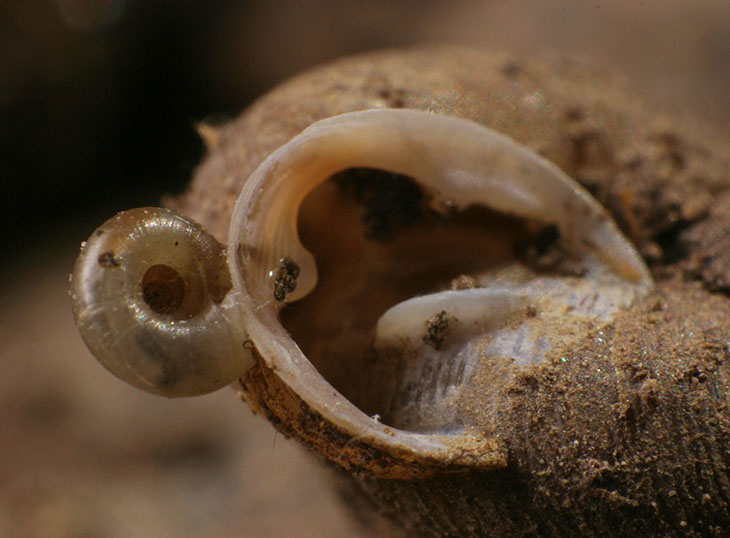

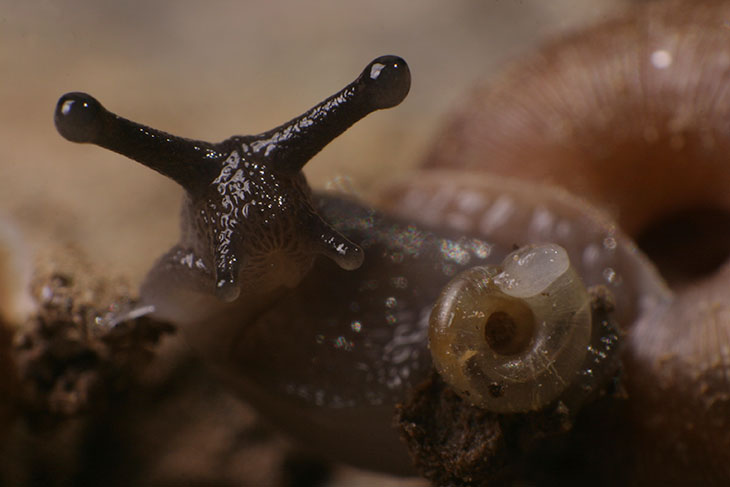
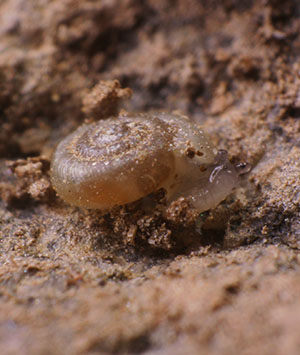 After a frantic ride of perhaps 10mm, the smaller one was eventually dislodged and tumbled to a stop, miraculously unharmed, as the larger snail thundered away blithely. I waited for a short while to get some pics of the smaller one emerging and toddling off, if only to ensure that it was not limping (picture that if you will.) If you look closely at this image, you can just see the eyestalks emerging to the far right, but after its traumatic ride the snail was understandably cautious and taking its own sweet time about it, which I will leave you to imagine. The sun was bright today and this isn’t ideal conditions for snails, so after a quick spritz of water, I soon returned them all to the shelter of the rocks whence they came, where I’m sure the stories will be traded this evening over long draughts of whatever it is that snails quaff.
After a frantic ride of perhaps 10mm, the smaller one was eventually dislodged and tumbled to a stop, miraculously unharmed, as the larger snail thundered away blithely. I waited for a short while to get some pics of the smaller one emerging and toddling off, if only to ensure that it was not limping (picture that if you will.) If you look closely at this image, you can just see the eyestalks emerging to the far right, but after its traumatic ride the snail was understandably cautious and taking its own sweet time about it, which I will leave you to imagine. The sun was bright today and this isn’t ideal conditions for snails, so after a quick spritz of water, I soon returned them all to the shelter of the rocks whence they came, where I’m sure the stories will be traded this evening over long draughts of whatever it is that snails quaff.
